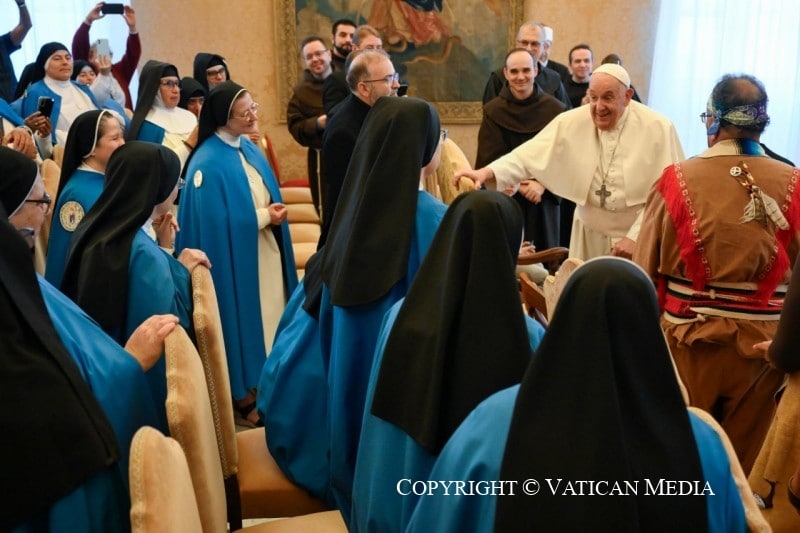Mother Agreda: the contemplative who evangelised America
Conference on Venerable María de Jesús de Ágreda promoted by the Pontifical International Marian Academy

This morning, in the Vatican Apostolic Palace, Pope Francis received in Audience the participants to the Convention on the Venerable María de Jesús de Ágreda promoted by the Pontifical International Marian Academy and addressed to them the following words of greeting:
Pope Francis, in his audience to the participants at the Convention on the Venerable María de Jesús de Ágreda, emphasised three lessons that the contemplative woman can give to the Church: silence, mysticism and mission.
Silence is an essential attitude for the contemplative life. It is the attitude of listening, of welcoming into the heart the voice of the Beloved, the eternal Word of the Father. Pope Francis emphasises that woman has a special vocation to listening. This is due to her sensitivity, her capacity for empathy and her intuition.
Mysticism is a relationship with God that stems from an attitude of listening. It is an ecstatic experience, but in the sense of coming out of oneself, out of one’s own comforts, out of the selfish ego that always tries to dominate us. It is about making space for God so that, docile to the Holy Spirit, we can receive Him in our home.
The mission is the expression of contemplative life in the world. Contemplative women, like Mother Agreda, are a testimony of love for God and neighbour. Their intercessory prayer is a powerful force that can transform the world.
 Holy Father’s greeting
Holy Father’s greeting
Dear brothers and sisters,
I welcome you, and I am happy to be able to receive you on the occasion of the international Conference on the Venerable María de Jesús de Ágreda, an event that is being held in the context of the Chair of Saint Beatriz de Silva, your foundress [of the Franciscan Conceptionists] who is somewhat forgotten. This chair, established by the Pontifical International Marian Academy, is a beautiful initiative, not only because of what it represents for the study of the mystery of the Immaculate Conception, but also because it was born under the auspices of a contemplative female order. I am therefore happy to be able to greet the Conceptionist Mothers – they are present in Argentina! – who have come here for the occasion.
Mother Ágreda was an exceptional woman, whom you wished to define as “in love with Scripture”, “Marian mystic” and “evangelizer of America”. These titles made me reflect on three lessons that the contemplative woman can give to the Church. The first lesson relates to silence, the attitude of listening, to welcome the voice of the Beloved, the eternal Word of the Father, in the heart. It is an attitude for everyone, but it is especially feminine: women know how to listen and have a special vocation for listening. It is surprising how, despite being without a specific formation, some religious sisters have attained a noteworthy knowledge of Scripture and, in the school of prayer, have drunk from it as though it were a living fountain. Therefore, to describe them as “in love with” Scripture is an expression that goes beyond praising its use in their writings; it is seeing Christ Himself who speaks to them and speaks to us through His Word, asking that, following Mary’s example, we keep everything in our hearts (cf. Lk 2:51).
The second lesson is the mystic, that is, a relationship with God that is born from this attitude of listening, from this incarnate reading of the Sacred Scripture. An experience, we might say, ecstatic, but by “ecstasy” we mean coming out of ourselves, coming out of our comforts, out of the selfish ego that always tries to dominate us. It is a matter of making room for God, so that, docile to the Holy Spirit, the King’s “overseer”, we can welcome Him into our home. This is the example of Mary, who welcomed Him into her Immaculate Heart before she welcomed Him into her virginal womb. In this sense, contemplatives teach us, through a path of asceticism, abandonment and fidelity, the joy of living only for Him. And sometimes contemplation is done in silence, before the Lord, in silence. And in this world that is always full – of things, words, news, a whole industry of exterior communication – interior communication, in silence, is so necessary.
The third lesson is mission. Mother Ágreda and the Conceptionist religious sisters, who were the first cloistered nuns to arrive in America – I don’t know if they arrived with Christopher Columbus, but not long after – give us the proof of this missionary spirit in contemplative life, which Saint Thérèse of the Child Jesus would later highlight. It is not a coincidence that another great mystic, Saint Rose of Lima, is the first saint of the continent.
It is understandable that Mother Ágreda heard the call of the Lord to pray for those souls who did not yet know Him, and that this prayer was fruitful in the soul of those who, as the missionaries said, were well-disposed to receive baptism. We are not usually aware of the power of intercessory prayer in our lives, as the Indians are said to have been by Mother Ágreda’s intervention. But, as Mary teaches us at the wedding in Cana, we too can recognize where the new wine comes from through those who support us with their prayer and edify us by their example. Do not forget Mary’s great gesture, revealed to us at the wedding in Cana. Mary never points to herself, Mary indicates her Son: “Do whatever He tells you!”. She leads us to Jesus, she generates Him in us. And we must imitate this beautiful attitude, pointing to the Lord in our turn.
_________________________________
Holy See Press Office Bulletin, 16 November 2023
Related

Pope Francis’ Catechesis: The Rich Man. Jesus “Looked at Him with Love”
Exaudi Staff
09 April, 2025
4 min

Francis is recovering: progressing progressively
Exaudi Staff
08 April, 2025
2 min

The Pope to the Salesians: “Serve others without holding anything back”
Irene Vargas
07 April, 2025
2 min

The Pope: In convalescence, I feel the “finger of God” and experience his loving caress
Exaudi Staff
06 April, 2025
2 min
 (EN)
(EN)
 (ES)
(ES)
 (IT)
(IT)

